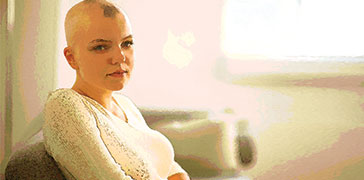US Pharm. 2022;47:15-16.

Autoimmune Hair Loss
Alopecia areata (AA) is a type of hair loss caused by an autoimmune response in the body. It can happen at any age, but it commonly occurs beginning in childhood. The overall incidence of AA has more than doubled in the past 10 years for unknown reasons. More than half of the individuals with AA are diagnosed before age 20 years, and pediatric cases account for almost 20% of total AA cases. Recent studies have demonstrated that Hispanic and Asian children are at an elevated risk of the condition, with a rate of occurrence two and three times more likely than average.
Stressors Can Trigger Attacks
Alopecia areata is a hair-loss disorder caused by an autoimmune response, which means the body’s immune cells attack the hair bulb. Individual hairs grow from the hair bulb, which sits at the base of the hair follicle. Under typical circumstances, hair follicles are protected from immune-system detection. Physical and emotional stressors can disrupt this protective mechanism and make the hair follicle vulnerable to attack. In the case of stress-induced hair loss, the hair shedding usually begins 2 to 4 months after the stressful event. The immune response that underlies AA does not cause permanent damage to the hair bulb or follicle, and the hair can grow back.
Many children with AA have another family member who has also been diagnosed with alopecia. This suggests there may be a genetic cause for some. Other autoimmune conditions frequently occur in the same individuals with AA, including the skin condition vitiligo, thyroid gland inflammation, and anemia.
Circular Hairless Patches on the Scalp
People with AA have well-defined, often circular patches of hair loss with healthy-appearing skin. Hair loss can occur at any location, but it most commonly affects the follicles in the scalp and beard. Hair loss occurs quickly and can progress to total hair loss on the scalp. Complete hair loss is called alopecia areata totalis (AT). When hair is lost across the entire body, it is called alopecia areata universalis (AU). Although approximately half of the individuals are likely to have spontaneous regrowth of their hair within a year of the episode, about 5% of AA cases will eventually progress to the more severe forms (AT and AU). Other physical symptoms that can occur are pitting and ridges in the fingernails.
Nearly 80% of people with limited, patchy AA spontaneously recover and never experience an episode again. However, losing one’s hair can result in significant psychological pain and suffering, and the hair can take up to a year to regrow. Children are particularly susceptible to a negative impact on their quality of life and self-confidence. In some extreme cases, AA episodes could even be a reason for suicidal ideation. Therefore, prompt and adequate treatment is essential to prevent the negative consequences of hair loss.
Treatment Is Challenging in Children
Depending on the age and extent of hair loss, doctors may choose different treatment modalities. The goal is to stimulate hair regrowth or stop the immune system from attacking. Therapeutic options for children and adolescents are limited because very few well-controlled clinical trials have been done. Examples of common treatments for children with AA include steroids applied to the skin, steroids given via injection, minoxidil (also known as Rogaine), and immunotherapy applied to the skin.
In June 2022, the FDA approved Olumiant (baricitinib) oral tablets to treat adult patients with severe alopecia areata. It is the first FDA approval of a systemic treatment (i.e., treats the entire body rather than a specific location) for AA. Still, it is not approved to treat children younger than age 18 years. Baricitinib is part of a class of drugs called Janus kinase inhibitors. They work by blocking immune signals and calming the immune system. They can cause side effects that are generally mild and reduce over time.
The content contained in this article is for informational purposes only. The content is not intended to be a substitute for professional advice. Reliance on any information provided in this article is solely at your own risk.
To comment on this article, contact rdavidson@uspharmacist.com.





